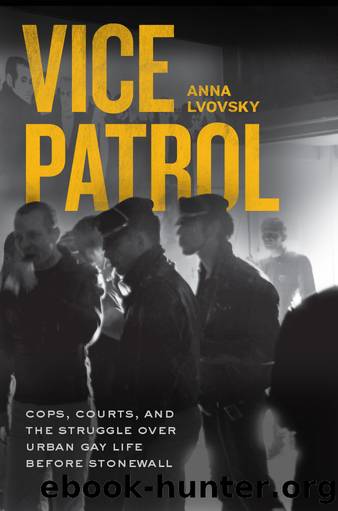Vice Patrol by Anna Lvovsky

Author:Anna Lvovsky [Lvovsky, Anna]
Language: eng
Format: epub
Tags: LAW000000 Law / General, LAW060000 Law / Legal History, SOC012000 Social Science / Gay Studies, HIS036060 History / United States / 20th Century, SOC026030 Social Science / Sociology / Urban
Publisher: University of Chicago Press
Published: 2021-05-24T00:00:00+00:00
FIVE
Peepholes and Perverts
On the night of October 1, 1961, Officer Walter Hetzel of the Long Beach Police Department climbed to the top of an outhouse at the Nu-Pike Amusement Park. There, just off the shore of the Pacific Ocean, by the glow of a nearby Ferris wheel, Hetzel looked down at a scene he would describe in court using far less romantic terms. Enlisted by the Nu-Pikeâs owner to âdo somethingâ about the men who frequented the parkâs toilets for sex, the department had installed a foot-long pipe through the roof of the menâs room, allowing a partial view into each of two separate adjoining booths. And it was through this pipe, that autumn evening, that Hetzel watched two men engage in a sexual act through an opening in the wall, each thinking himself fully shielded from view.1
From bars to parks to street corners, vice squads at midcentury patrolled a range of settings popular with men looking for sexual partners. But public restrooms inspired particular interest. More than a place to meet kindred spirits, bathrooms provided a convenient setting for the sexual act itselfâa fact that made those facilities, as the vice squads saw it, both a special public nuisance and the rare chance to make felony arrests. Apprehending the men suspected of such practices, however, was more easily said than done. Of all the systematic codes developed by queer men seeking partners in the mid-twentieth century, perhaps none were as systematic or effective as those used to consummate sexual acts in menâs rooms. As the sociologist Laud Humphreys observed in his landmark study of tearoom cruising in the late 1960s, men who pursued sexual contacts in bathrooms developed a range of âdefenses against outsiders,â from body language to spatial cues to audio signals, that allowed them both to initiate encounters and, just as quickly, to conceal them on a strangerâs approach. Those safeguards let cruisers pursue their activities beneath the noses of passersby, property owners, and policemen alikeâto maintain, as Humphreys put it, âprivacy in public.â2
Frustrated by those codes, officers like Hetzel found themselves forced to adopt a stealthier approach. From one-way mirrors to fake air vents to peepholes drilled directly behind toilets, police departments at midcentury devised a range of surreptitious tactics for spying on the interiors of public bathrooms. The diversity of those tactics is notable in its own right, a case study of the struggle between the police and gay men over the permissible use of public space. Trading in the possibility that innocent citizens might be exposed to careless cruisers for the near certainty that they would be exposed to peering policemen, the policeâs operations laid bare not just criminalized conduct but also hundreds of law-abiding men, unaware that their most private acts were being watched by the state. More than any other tool of vice enforcement, clandestine surveillance exemplifies the extent to which the statesâ antihomosexual campaigns redounded to the indignity of all citizens, gay and straight. And it exemplifies the viscerally unpleasant work
Download
This site does not store any files on its server. We only index and link to content provided by other sites. Please contact the content providers to delete copyright contents if any and email us, we'll remove relevant links or contents immediately.
2010-The City & the City by China Miéville(1959)
Anatomy of Injustice by Raymond Bonner(1639)
That Every Man Be Armed by Stephen P. Halbrook(1556)
ADHD on Trial by Michael Gordon(1550)
Injustices by Ian Millhiser(1477)
You Don't Own Me by Orly Lobel(1420)
Tell by Major Margaret Witt(1407)
Course Correction by Ginny Gilder(1384)
Broken Scales by Joel Cohen(1334)
Without Copyrights by Spoo Robert(1324)
A Vast Conspiracy by Jeffrey Toobin(1308)
First by Evan Thomas(1259)
A Religious Orgy in Tennessee by H.L. Mencken(1234)
J by Howard Jacobson(1228)
The Run of His Life: The People v. O. J. Simpson by Jeffrey Toobin(1189)
A Triumph of Genius: Edwin Land, Polaroid, and the Kodak Patent War by Ronald K. Fierstein(1185)
A History Of Thailand by Baker Chris(1159)
John Wayne Gacy by Judge Sam Amirante(1084)
Law 101: Everything You Need to Know About American Law, Fourth Edition by Jay Feinman(1073)
